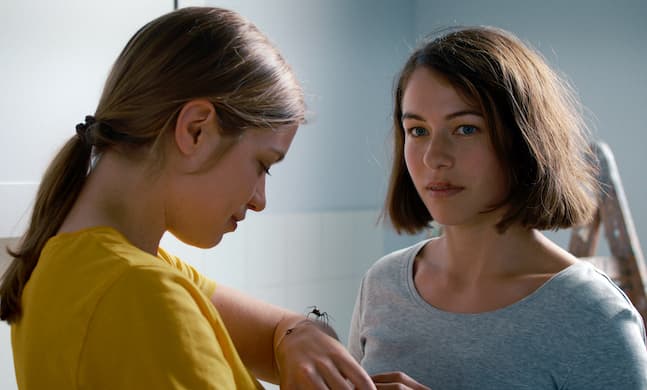Swiss Filmmakers Spin a Web of Odd Characters Overseen by a Spider
The film is an ensemble piece so diffuse it borders on Byzantine: Viewers may need a Venn diagram to keep tabs on each of the players.

The most striking scene in “The Girl and the Spider,” the second film from Swiss filmmakers Ramon and Silvan Zürcher, appears about halfway through the picture.
A 20-something woman wakes up during a thunderstorm and bumps her head on a window that has come ajar. Getting up, she spies an elderly woman standing on the roof of a building across the way. Wearing a nightgown, the old woman is drenched to her bones and gesticulating in an operatic manner. She makes no sound as she plays to the audience. The moment is simultaneously manic and magical, unseemly and darkly funny. It comes from out of nowhere.
The old woman is the otherwise circumspect Frau Arnold (Margherita Schoch), a peripheral character who staves off her loneliness by kidnapping a neighbor’s orange tabby. There are other moments in “The Girl and the Spider” that tap into the poetic, if not the supernatural.
Take, for instance, the piano or, rather, its former owner — a cleaning woman. The filmmakers take us back in time, early in the last century, to watch her tidying up a cabin in an ocean liner. The setting is stridently artificial, a kind of magic realism poaching upon 1950s cinema.
The film ends with a voiceover by the same woman musing on how, exactly, balance is achieved on a moving ship. As she does so, a montage spotlights, one by one, the present-day characters in the film, presumably as a mirror to the confounding relationships between them.
“The Girl and the Spider” takes place in an unnamed city in which German is the principal language. The mise en scène is cramped in terms of time-frame and setting.
The action takes place over the span of a few days. Lisa (Liliane Amuat) is moving into a new flat, and it is within the old and new apartments that events unfold. These spaces are overrun with temperamental friends, lanky movers, wandering neighbors, inquisitive children, and situations that are invariably awkward.
The film is an ensemble piece so diffuse it borders on Byzantine: Viewers may need a Venn diagram to keep tabs on each of the players. The mainstay is Mara (Henriette Confurius), a young woman with a surly mien and a prominent herpes sore on her upper lip. Is she Lisa’s spurned lover? Maybe. Mara is aggrieved, that’s for sure. At one point, she pours a cup of hot coffee on a dog that’s wandered into the room. Mara has issues.
Lisa’s mother, Astrid (Ursina Lardi), doesn’t like Mara, and Mara has it out for Lisa’s mother. No one in “The Girl and the Spider” much likes anyone else, and few characters are much worth liking. Disdain, distrust, and resentment rule. That doesn’t stop a variety of erotic overtures from occurring — few being consummated, most unresolved, and all pansexual in nature. Everyone is willing; few are satisfied.
The Brothers Zürcher like their symbolism. “The Girl and the Spider” is interrupted several times by close-ups of a jack-hammer loosening up concrete. An architectural blueprint that opens the film is altered, throughout the course of the story, by the addition of scrawled drawings. Ultimately, it’s engulfed by a fluid — wine, perhaps — that is a peculiarly lurid shade of red. Did I mention that the fluid gushes forth from a styrofoam coffee cup that has been punctured by a pencil?
A lone spider hovers over the proceedings. Sundry characters take notice of it, and let the spider crawl over their fingers. What this all portends or why the spider gets title billing is, like most of the movie, purposefully moot. The Zürchers wouldn’t have it any other way: Obfuscation is their MO. Should you like your frustrations put into motion with tight-lipped precision, “The Girl and the Spider” is for you.

